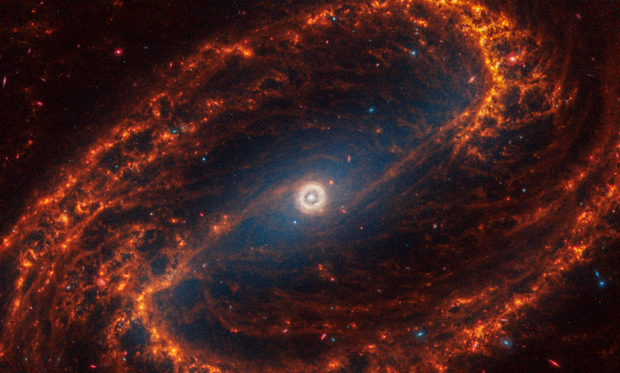[ad_1]
A “treasure trove” of stunning new images showing 19 spiral galaxies have been captured by NASA’s James Webb Space Telescope, the European Space Agency said on Monday. The images reveal “stars, gas, and dust on the smallest scales ever observed beyond our own galaxy,” the Milky Way, the agency said.
According to the agency, researchers are analyzing the new images to find out how these galaxies originated. NASA says they were taken as part of the Physics at High Angular resolution in Nearby GalaxieS (PHANGS) program, and show off millions of stars that “sparkle in blue tones.” They also reveal “glowing dust,” and stars that are still developing, NASA said.
Some of the “newest, most massive stars in the galaxies,” can be found in the images, said Erik Rosolowsky, a physics professor at the University of Alberta in Edmonton, Canada. PHANGS researchers have also released what NASA says is the largest catalog ever of roughly 100,000 star clusters, a list that Rosolowsky says allows for analysis “vastly larger than anything our team could possibly handle.”
But that isn’t all. Researchers said the galaxy pictures also show off “large, spherical shells” that were possibly created by exploding stars, as well as supermassive black holes, which can be seen as galaxy cores with pink and red spikes.
Janice Lee, a project scientist for strategic initiatives at Baltimore, Maryland’s Space Telescope Science Institute, said the galaxy images are “extraordinary.”
“They’re mind-blowing even for researchers who have studied these same galaxies for decades,” Lee said. “Bubbles and filaments are resolved down to the smallest scales ever observed, and tell a story about the star formation cycle.”
See the 19 new images of spiral galaxies below.
Spiral galaxy IC 5332
NASA, ESA, CSA, STScI, Janice Lee (STScI), Thomas Williams (Oxford), Rupali Chandar (UToledo), PHANGS Team
Spiral galaxy NGC 628
NASA, ESA, CSA, STScI, Janice Lee (STScI), Thomas Williams (Oxford), PHANGS Team
Spiral galaxy NGC 1087
NASA, ESA, CSA, STScI, Janice Lee (STScI), Thomas Williams (Oxford), Rupali Chandar (UToledo), PHANGS Team
NGC 1300
NASA, ESA, CSA, STScI, Janice Lee (STScI), Thomas Williams (Oxford), PHANGS Team
NGC 1365
NASA, ESA, CSA, STScI, Janice Lee (STScI), Thomas Williams (Oxford), PHANGS Team
NGC 1385
NASA, ESA, CSA, STScI, Janice Lee (STScI), Thomas Williams (Oxford), PHANGS Team
Spiral galaxy 1433
NASA, ESA, CSA, STScI, Janice Lee (STScI), Thomas Williams (Oxford), PHANGS Team
Spiral galaxy NGC 1512
NASA, ESA, CSA, STScI, Janice Lee (STScI), Thomas Williams (Oxford), PHANGS Team
Spiral galaxy NGC 1566
NASA, ESA, CSA, STScI, Janice Lee (STScI), Thomas Williams (Oxford), Rupali Chandar (UToledo), Daniela Calzetti (UMass), PHANGS Team
Spiral galaxy NGC 1672
NASA, ESA, CSA, STScI, Janice Lee (STScI), Thomas Williams (Oxford), PHANGS Team
Spiral galaxy NGC 2835
NASA, ESA, CSA, STScI, Janice Lee (STScI), Thomas Williams (Oxford), PHANGS Team
Spiral galaxy NGC 3351
NASA, ESA, CSA, STScI, Janice Lee (STScI), Thomas Williams (Oxford), PHANGS Team
Spiral galaxy NGC 3627
NASA, ESA, CSA, STScI, Janice Lee (STScI), Thomas Williams (Oxford), PHANGS Team
Spiral galaxy NGC 4254
NASA, ESA, CSA, STScI, Janice Lee (STScI), Thomas Williams (Oxford), PHANGS Team
Spiral galaxy NGC 4303
NASA, ESA, CSA, ESO, STScI, Janice Lee (STScI), Thomas Williams (Oxford), PHANGS Team
Spiral galaxy NGC 4321
NASA, ESA, CSA, STScI, Janice Lee (STScI), Thomas Williams (Oxford), PHANGS Team
Spiral galaxy NGC 4535
NASA, ESA, CSA, STScI, Janice Lee (STScI), Thomas Williams (Oxford), PHANGS Team
Spiral galaxy NGC 5068
NASA, ESA, CSA, STScI, Janice Lee (STScI), Thomas Williams (Oxford), PHANGS Team
Spiral galaxy NGC 7496
NASA, ESA, CSA, STScI, Janice Lee (STScI), Thomas Williams (Oxford), PHANGS Team
Thanks for reading CBS NEWS.
Create your free account or log in
for more features.
[ad_2]
Source





















Leave a Reply